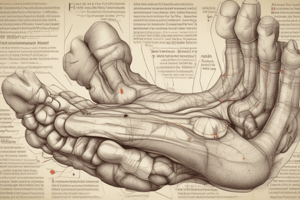Podcast
Questions and Answers
What does the 'Number of pack-years' formula calculate?
What does the 'Number of pack-years' formula calculate?
- Average number of cigarettes smoked daily
- Years of life lost due to smoking
- Cost of smoking per year
- Cumulative exposure to smoking over time (correct)
What is the purpose of summarizing the history during a patient interview?
What is the purpose of summarizing the history during a patient interview?
- To fill out necessary paperwork
- To ensure the patient can correct any errors or misunderstandings (correct)
- To allow the patient to provide additional information
- To make the interview shorter
Which component is NOT typically included in a patient's medical history?
Which component is NOT typically included in a patient's medical history?
- Social history
- Patient's favorite foods (correct)
- Past surgical history
- History of presenting complaint
What is the role of 'differential diagnosis' in history taking?
What is the role of 'differential diagnosis' in history taking?
During a patient interview, what is the primary goal of introducing yourself carefully?
During a patient interview, what is the primary goal of introducing yourself carefully?
Flashcards
Medical History
Medical History
Detailed account of a patient's health, including symptoms and past illnesses.
History of Presenting Complaint
History of Presenting Complaint
Patient's account of the current health problem or reason for the visit.
Past Medical History
Past Medical History
Record of previous illnesses, treatments, and surgeries.
Past Surgical History
Past Surgical History
Signup and view all the flashcards
Review of Systems (ROS)
Review of Systems (ROS)
Signup and view all the flashcards
Social History
Social History
Signup and view all the flashcards
Pack-Years
Pack-Years
Signup and view all the flashcards
Case History
Case History
Signup and view all the flashcards
Anamnesis
Anamnesis
Signup and view all the flashcards
Clinical Signs
Clinical Signs
Signup and view all the flashcards
Differential Diagnosis
Differential Diagnosis
Signup and view all the flashcards
Summary of History
Summary of History
Signup and view all the flashcards
Patient Feedback
Patient Feedback
Signup and view all the flashcards
Inhibiting Factors
Inhibiting Factors
Signup and view all the flashcards
Study Notes
History Taking
- History taking is a crucial part of medical practice.
- Key components include medical history, case history, and anamnesis.
- Further steps include examining symptoms, clinical signs, differential diagnosis, and history and physical.
- Introduction of the medical professional is essential.
- Patient identification is a key aspect (date of birth, sex, ethnicity).
- The presenting complaint is vital for diagnosis. (Patient example: James Taylor, age 55, height 5'8", weight 170lbs.)
- The patient's chief complaints were biliary colic pain, sweating, and yellow skin.
Pain Assessment
- The "SOCRATES" rule is used assessment of pain. (Site, Onset, Character, Radiating, Associated Symptoms, Timing, Exacerbating/Relieving Factors, Severity).
- A pain assessment model is used to guide professionals to precisely understand the nature of the pain. Components of the model are described (Site, Onset, etc).
Pain Assessment Tools
- A Universal Pain Assessment Tool is a method to assess pain. The tool enables professionals to describe the patient's pain via scale (0-10).
- Different methods exist to describe the nature and severity of pain using various scales/methods.
Medical History
- Past medical history is relevant for a complete medical image.
- Past surgical history needs to be included.
- Additional aspects to include are symptoms, allergies, medications, pertinent medical history, last meal, event leading up to the injury or illness
Medication List
- A medication list should be compiled accurately for patient care.
Review of Systems (ROS)
- A review of body systems (ROS) is critical for comprehensive patient care. Information is given regarding specific areas (brain, upper body, chest, lungs, etc.).
Family Information
- Family information is relevant in patient care.
- A family history diagram, called Family Tree, aids data collection.
Social History
- Social history includes factors such as smoking (pack-years = (packs smoked per day) x (years as a smoker)) and alcohol consumption.
- Understanding of alcohol consumption and classification is important. Examples of how to classify drinking are given.
Summary of History
- This section summarizes the key points of the patient's case history, including demographic information, chief complaints, pain scale, body temperature, allergies, medications, past medical history, family history, drug use, and occupation.
Patient Feedback
- Patient feedback is essential in medical practice.
Inhibitive Factors
- Inhibiting factors are potential obstacles. (This section includes an image referencing obstacles in treatment).
Studying That Suits You
Use AI to generate personalized quizzes and flashcards to suit your learning preferences.




